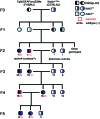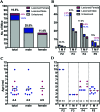Spontaneous Development of Cutaneous Squamous Cell Carcinoma in Mice with Cell-specific Deletion of Inhibitor of κB Kinase 2
- PMID: 28935002
- PMCID: PMC5621568
Spontaneous Development of Cutaneous Squamous Cell Carcinoma in Mice with Cell-specific Deletion of Inhibitor of κB Kinase 2
Abstract
The deletion of NFκB in epithelial tissues by using skin-specific promoters can cause both tumor formation and severe inflammatory dermatitis, indicating that this signaling pathway is important for the maintenance of immune homeostasis in epithelial tissues. In the present study, we crossed mice transgenic for loxP-Ikbk2 and human Gfap-cre to selectively delete IKK2 in CNS astrocytes. Unexpectedly, a subset of mice developed severe and progressive skin lesions marked by hyperplasia, hyperkeratosis, dysplasia, inflammation, and neoplasia with a subset of lesions diagnosed as squamous cell carcinoma (SCC). The development of lesions was monitored over a 3.5-y period and over 4 filial generations. Average age of onset of was 4 mo of age with 19.5% of mice affected with frequency increasing in progressive generations. Lesion development appeared to correlate not only with unintended IKK2 deletion in GFAP expressing cells of the epidermis, but also with increased expression of TNF in lesioned skin. The skins changes described in these animals are similar to those in transgenic mice with an epidermis-specific deletion of NFκB and thus represents another genetic mouse model that can be used to study the role of NFκB signaling in regulating the development of SCC.
Figures






Similar articles
-
Tissue specific deletion of inhibitor of kappa B kinase 2 with OX40-Cre reveals the unanticipated expression from the OX40 locus in skin epidermis.PLoS One. 2012;7(2):e32193. doi: 10.1371/journal.pone.0032193. Epub 2012 Feb 21. PLoS One. 2012. PMID: 22363815 Free PMC article.
-
Localized inflammatory skin disease following inducible ablation of I kappa B kinase 2 in murine epidermis.J Invest Dermatol. 2006 Mar;126(3):614-20. doi: 10.1038/sj.jid.5700092. J Invest Dermatol. 2006. PMID: 16397523
-
Hair follicle defects and squamous cell carcinoma formation in Smad4 conditional knockout mouse skin.Oncogene. 2006 Jan 12;25(2):207-17. doi: 10.1038/sj.onc.1209029. Oncogene. 2006. PMID: 16170355
-
Cyclooxygenase-dependent signaling is causally linked to non-melanoma skin carcinogenesis: pharmacological, genetic, and clinical evidence.Cancer Metastasis Rev. 2011 Dec;30(3-4):343-61. doi: 10.1007/s10555-011-9306-z. Cancer Metastasis Rev. 2011. PMID: 22038018 Review.
-
IκB kinase alpha and cancer.J Interferon Cytokine Res. 2012 Apr;32(4):152-8. doi: 10.1089/jir.2011.0107. Epub 2011 Dec 7. J Interferon Cytokine Res. 2012. PMID: 22149351 Free PMC article. Review.
Cited by
-
Context-Dependent Role of IKKβ in Cancer.Genes (Basel). 2017 Dec 8;8(12):376. doi: 10.3390/genes8120376. Genes (Basel). 2017. PMID: 29292732 Free PMC article. Review.
-
Genetic suppression of IKK2/NF-κB in astrocytes inhibits neuroinflammation and reduces neuronal loss in the MPTP-Probenecid model of Parkinson's disease.Neurobiol Dis. 2019 Jul;127:193-209. doi: 10.1016/j.nbd.2019.02.020. Epub 2019 Feb 25. Neurobiol Dis. 2019. PMID: 30818064 Free PMC article.
-
Next generation mouse models of squamous cell lung cancer for translational immuno-oncology.Oncotarget. 2020 Dec 1;11(48):4463-4464. doi: 10.18632/oncotarget.27828. eCollection 2020 Dec 1. Oncotarget. 2020. PMID: 33400725 Free PMC article. No abstract available.
-
Profile of Basal Cell Carcinoma Mutations and Copy Number Alterations - Focus on Gene-Associated Noncoding Variants.Front Oncol. 2021 Nov 25;11:752579. doi: 10.3389/fonc.2021.752579. eCollection 2021. Front Oncol. 2021. PMID: 34900699 Free PMC article.
-
Inflammation: A key process in skin tumorigenesis.Oncol Lett. 2019 May;17(5):4068-4084. doi: 10.3892/ol.2018.9735. Epub 2018 Nov 19. Oncol Lett. 2019. PMID: 30944600 Free PMC article. Review.
References
-
- Banno T, Gazel A, Blumemberg M. 2005. Pathway-specific profiling identifies the NFκB-dependent tumor necrosis factor α-regulated genes in epidermal keratinocytes. J Biol Chem 280: 18973–18980. - PubMed
-
- Bonizzi G, Karin M. 2004. The 2 NFκB activation pathways and their role in innate and adaptive immunity. Trends Immunol 25:280–288. - PubMed
MeSH terms
Substances
Grants and funding
LinkOut - more resources
Full Text Sources
Medical
Research Materials
Miscellaneous
